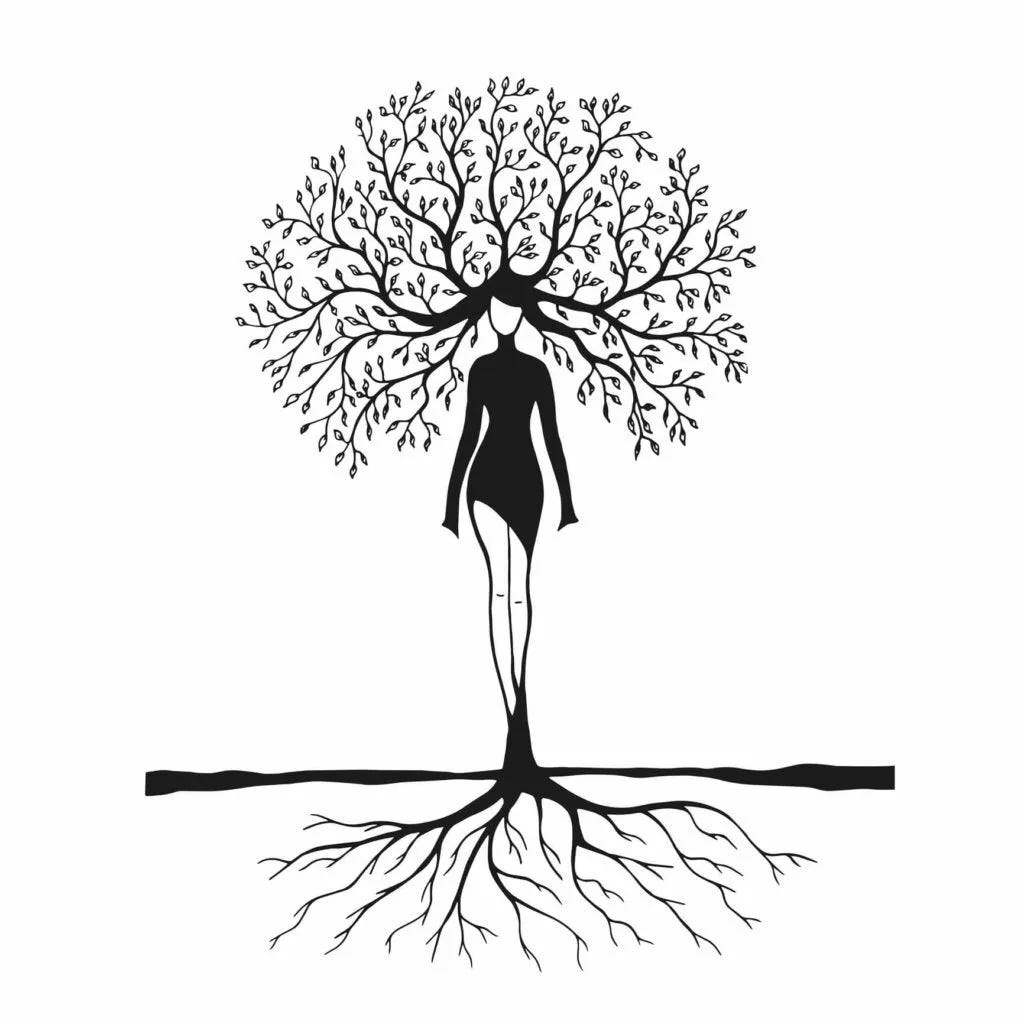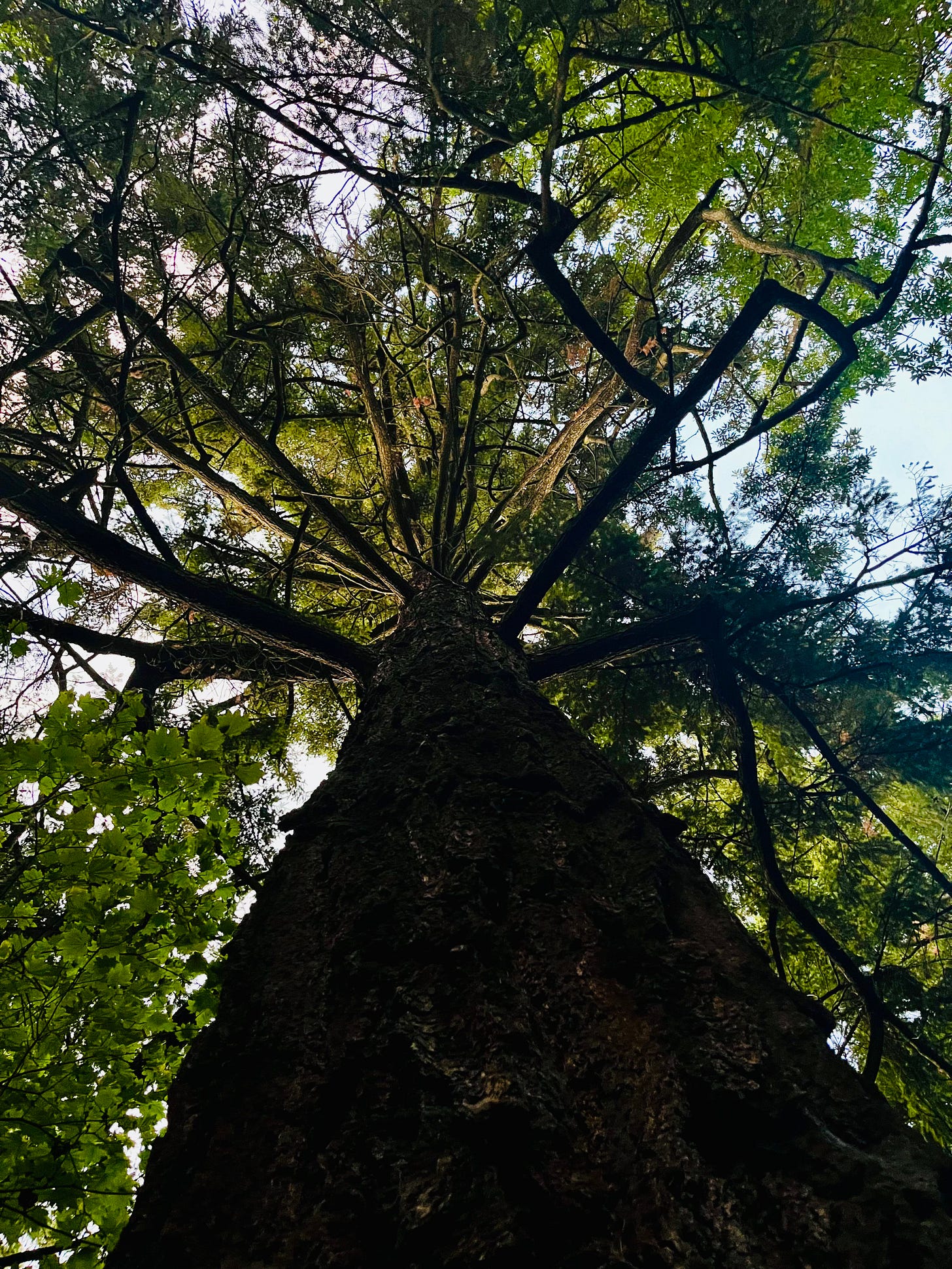Part 1:
A subscriber asked and encouraged me to write more about embodiment. This publication is called The Nano, with the tagline “writing and embodiment practices for our collective liberation.” So, yeah, high time to write a post about what I mean when I say embodiment (or somatics, a term I use interchangably).
But whew, I’ve been writing this post for weeks. I wrote at least 4000 words then cut most of them. I’m starting over again. I don’t know if it’s the change of season, the shift to the school schedule, equinox loss of sunlight, my spouse coming back to our house after over 50 days “gone fishing,” or the ongoing gifts of menopause, but I’ve been all over the place since the beginning of August; peripatetic in my day-to-day doings and scatter-brained in my writing practice, my household chores, and to-do lists.
Or maybe—just maybe—my struggle to keep myself focused for any length of time is a natural outcome of my interconnected human body sensing and witnessing in real time multiple crises occurring exponentially around the globe. From the time my body joined the corporeal realm here on earth, natural disasters alone have increased tenfold, from 39 incidents in 1960 (I was born in ‘69) to 396 in 2019, according to the Institute for Economics and Peace. And that research was conducted before the Covid-19 pandemic, the 2020 wildfires, and last week’s “unprecedented” floods affecting the inland South, etc. If you are feeling brave, you can read a 2023 updated report here.1
Climate, racial, religious, and other human-rights disasters—experienced up-close-and-personal or or via constant livestream—is enough to make any body (soma) feel unstable, ungrounded, and quaky. This transition time is hard and painful. Embodiment and somatics practice means we pay deep attention to our muscles and tendons, skin, bloodstream and nerves. We honor our gut feelings, we pay attention to our hair standing on end, we notice our heart racing, and we lay on the ground when we are exhausted. Embodiment means sensing all the feelings, images, fears, guilt, anxiety, ecetera, ecetera that come up all the time, many times a day. For me evil doings stem from numbness. Embodiment is a commitment to practice techniques that soothe, regulate, and keep our bodily systems alive even under the most trying circumstances. In my practice, my goal is to not discharge any unregulated energy onto others, thereby creating wreckage.
***
Part 2:
By the time I took on a professional job teaching youth and adults about the dynamics of interpersonal violence, I’d already been criticized plenty of times (by teachers, managers, roommates, family members) for rolling my eyes, sighing too loudly, stretching my shoulders, or any other number of physical things my body did naturally to release tension (and often called “unlady-like). In my violence-prevention work, I started to understand and appreciate how our bodies process difficult information and experiences. In the early 1990s, educators talked about VARK—Visual, Auditory, Reading, and Kinesthetic—a mnemonic device to help teachers ensure all kinds of learners were included in our classrooms. Once I learned about VARK, for every volunteer training, lesson plan, or even group presentation, I incorporated at least a little bit of each kind of learning style no matter the age of my audience. When participants got up and moved around a room or gymnasium in some directed fashion, I noticed a tension release.
For example, in classes, I often used a walking (or wheeling) back and forth exercise in a room broken into three parts with simple signs that read, "Often, Sometimes, and Never.” I told students to “Walk under the sign most true for you regarding the following statement: You’ve been told, ‘You’re too young to understand.’” Right away students (particularly youth), grunted or threw up their hands and then slapped their thighs. They had immediate, involuntarily somatic responses to the statement as they traveled to the signs. They also sighed loudly, rolled their eyes, stretched their bodies. With that particular question, no matter the age, most participants gathered under the “Often” sign, several under “Sometimes,” and rarely anyone under “Never.” I’d ask how the audience felt about being told they’re too young to understand. “I hate when my parents say that,” a young student almost always said. Others would agree. Often after an intentional kinesthetic exercise, conversations shifted from me as teacher to audience as community participants. After some somatic movement, people were more likely to share their own stories with vulnerability and softness and even tears.
For yourself, take a pause right now. Think about that exercise. Notice how your body feels, whether or not you’ve been told you were too young to understand. What do you sense in your body? Is there a vibration or a clammy feeling? How would you name the feeling? Is there guilt, grief, gratitude or some combination of all three?
Kinesthetic, experiential, somatic exercises help us all physiologically integrate difficult facts, especially the reality of the terrible ways some people (or groups of people) can treat other human beings.
***
Part 3:
Of course we start with ourselves, our specific corporeal experiences of trauma and hardship that shaped our bodies, often from an early age. Noticing in the present how our soma feels and what sensations arise when certain difficult events happen is important. Somatic therapy and embodiment exercises can be key components to our personal healing. And yet, as a former yoga teacher used to say, “strength without flexibility is useless.” For my money (and why this post is free!), embodiment and somatics practices are useless (or, since that word is a little harsh, at least ineffective) if we do not also have a lens of human and environmental justice.
Too many embodiment programs out there are focused on individual healing without enough analysis of how interpersonal violence—from domestic violence to sexual assault to child abuse to elder abuse to police brutality to bombing tent encampments—continues because powerful systems implicitly or explicitly condone the violence, usually for the purposes of increased profit, property, and power.
In my life, many times I’ve been asked some version of the following question, “Why does it always have to be about race (or gender), Nancy?” I’ll answer that pretty defensive question with what I understand to be most true—"it” (my writing, my Work with the capital W) has to be about race and gender because for all our lip service about equality in America, the unhealed lesions of supremacy—specifically white supremacy and patriarchy—are still gargantuan, un-repaired causes of internalized and externalized violence.
White supremacy and patriarchy are not facts; they’re beliefs and doctrines that say one group of people (white people and males) are “better than” other groups of people (people of color, female bodies, and queer people). The dominant group gains power by using individual interpersonal violence, yes, but also by creating institutions, religions, laws, policy, and militarization that implicitly or explicitly condone and perpetuate violence against the group deemed “less than.” Traditions and cultural expression often continue the perpetuation of the violence and the normalizing of hierarchical systems.
Imagine seeing a Black man on the ground with a knee on his neck crying out for his mother, or a brown child wailing in pain from under the rubble, and then not making any noise at all? Pause. Do you feel bracing in your muscles? Constriction in your chest? Tension in your shoulders? What’s happening in your belly? Are your toes curled tight? Embodiment requires those of us in white-identifying bodies in particular to pay attention to any knee-jerk, survival-based reactions (i.e., “why do you have to talk about this all the time?”) and instead take a breath so we might choose a grounded, undefended response instead.
I practice embodiment because I want to change our culture from one where hierarchies exist to one where all people are not simply created equal but treated equal. Where power comes from our choice to see the interconnectedness of our human bodily systems, not man-made top-down caste systems. I especially want to help white women who witness and experience interpersonal violence every day see see the systems behind that violence so that we might find our own personal power to choose love and then labor for our collective liberation.
Part 4:

Now, having written the above, plus the other 4000 words saved in a file folder I may or may not share later, I do not proclaim to be nor want to be any kind of expert on embodiment! The reason I titled this post Embodiment in the Messiness is because my last year has been extremely messy, with entire household moves, parent declines, a family death, job loss, income loss, family love and abundance and beauty and grief galore. I practice writing and embodiment in the basement of our house, the location of my office and the staging area for all of these household moves: boxes of artwork leaning against walls, tubs of goods stacked on the floor, books, papers, bedding, blankets and fabric everywhere. I feel ungrounded a lot; so I practice embodiment to come back to the present moment again and again. I also have a monthly practice group with other white folks comitted to justice; we help each other out.
People of the global majority and strategically undervalued folks are (and I believe should be) the experts of these practices. Somatic leaders like Resmaa Menakem, Prentiss Hempill, Myish T Hill, and many others who I follow are who I refer you to for deeper dives and your money.
A few recommendations as well:
Kelsey Blackwell’s Substack, The Drinking Gourd is good and I found Kelsey because of this article in The Arrow, which spoke to me.
Read “Did This Radicalize You, Really?” by Ijeoma Oluo and subscribe to her Behind the Book Substack.
On my email signature I have one of my favorite lines of poetry from William Stafford—poet laureate of Oregon and conscientious objector to war—“justice will take us millions of intricate moves.” May you do your moves to get to justice.
Thank you for reading this post. My next post will be about how poetry is a practice that can also help us get embodied. If you’re interested in poetry, please consider becoming a paid subscriber to get access to my Poetry for the People section, an ongoing, series of lecturettes, readings, and videos about the craft elements of poetry. Writing exercises and practice examples included.
If you liked this post, please feel free to share.
The Nano is a reader-supported publication.
Institute for Economics & Peace. Ecological Threat Report 2023: Analysing Ecological Threats, Resilience & Peace, Sydney, November 2023. Available from: http://visionofhumanity.org/resources (accessed 30/09/2024).







So thoughtful and intelligent Nancy! I heard your true voice here and appreciated it. A lot of deep breaths taken. Please say more about all of it!